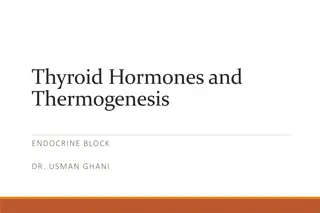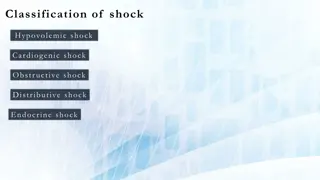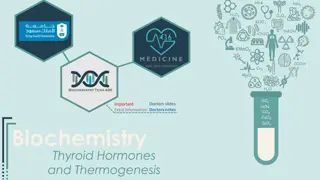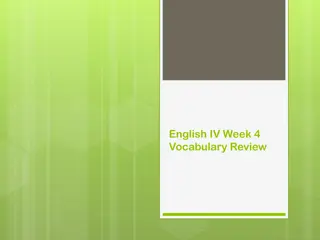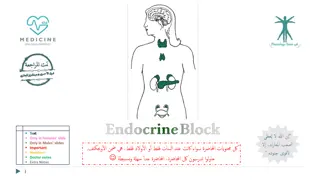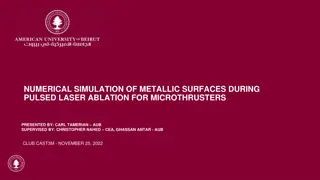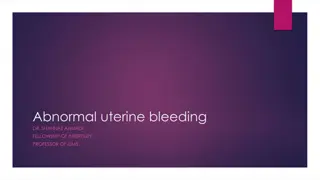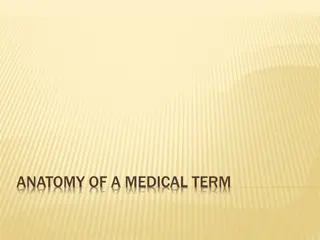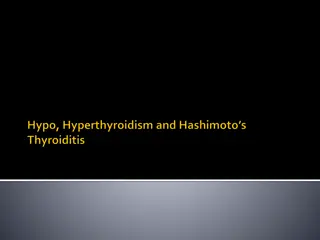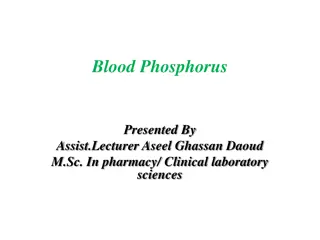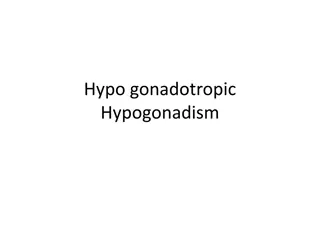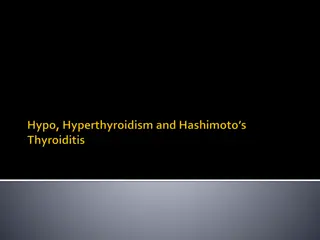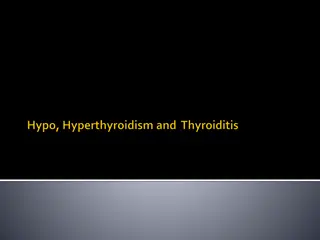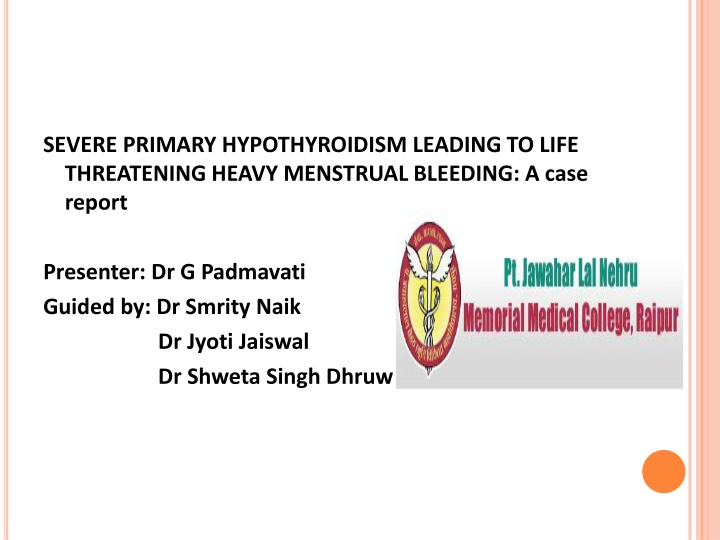
Severe Primary Hypothyroidism Leading to Life-Threatening Menstrual Bleeding Case Report
A case report discussing the relationship between severe primary hypothyroidism and life-threatening heavy menstrual bleeding in an 18-year-old girl. The report covers her symptoms, diagnosis, investigations, management, and outcomes, emphasizing the importance of recognizing and treating hypothyroidism to prevent serious complications.
Download Presentation

Please find below an Image/Link to download the presentation.
The content on the website is provided AS IS for your information and personal use only. It may not be sold, licensed, or shared on other websites without obtaining consent from the author. If you encounter any issues during the download, it is possible that the publisher has removed the file from their server.
You are allowed to download the files provided on this website for personal or commercial use, subject to the condition that they are used lawfully. All files are the property of their respective owners.
The content on the website is provided AS IS for your information and personal use only. It may not be sold, licensed, or shared on other websites without obtaining consent from the author.
E N D
Presentation Transcript
SEVERE PRIMARY HYPOTHYROIDISM LEADING TO LIFE THREATENING HEAVY MENSTRUAL BLEEDING: A case report Presenter: Dr G Padmavati Guided by: Dr Smrity Naik Dr Jyoti Jaiswal Dr Shweta Singh Dhruw
INTRODUCTION Abnormal uterine bleeding (AUB) is defined as any deviation from normal menstrual cycle pattern. 10-20% women in their reproductive life experience AUB and 20-30% of Indian women presents to OPD with this complaint.1 Prevalence of menstrual irregularities in patients with untreated hypothyroidism was reported to be 23.4%. An Indian study reported 68.2% of hypothyroid women had menstrual abnormalities compared to 12.2% of healthy controls.2
CASE REPORT A 18yr old unmarried girl was admitted in our hospital with complaints of heavy menstrual bleeding with clots, generalized weakness and breathlessness since 2 days. She was very weak, unable to move or talk to anyone and She had problems in correctly recalling the past events. . Her previous menstrual cycles were irregular (3-5mths). H/O delayed milestones, loss of appetite and hoarseness of voice. On admission she was very pale and dehydrated. Edema was present over face, hands and feet, peripheries were cold and clammy. Skin was dry and scaly, nails were brittle and with short neck. Although BP was 50/30 mmHg but her pulse rate was 82bpm. She was tachypnoeic and SpO2 was 80% on room air. Her height was 126 cm (less than 5thcentile according to WHO growth chart) Immediate resuscitation with crystalloids, colloid (while waiting for blood) and blood transfusion done. Pregnancy was ruled out. To arrest bleeding- inj Tranexamic acid 500mg stat, inj ethymsylate 500mg 6 hourly and tablet Norethisterone 10mg TDS was started
INVESTIGATIONS Investigation Hb- 1.1gm/dl( ) with normal TLC and platelet. BT, CT, PT, INR LFT,RFT, serum electrolytes were on normal range. USG showed endometrial thickness of 14 mm inspite of heavy bleeding since 2days.Increased echogenicity of bilateral renal cortex was found. TSH was very high 100 IU/ml ( ) with decreased T4-0.678 g/dl and T3-0.359ng/ml suggestive of severe primary Hypothyroidism. S. prolactin was slightly raised (37.94ng/ml) but no galactorrhea found. LH and FSH were also decreased.
MANAGEMENT Endocrinologist was consulted and tablet Levothyroxine 100 g OD started. After 5 units of blood transfusion her hemoglobin improved to 8.35g/dl. Oral treatment for anemia started and dose of tablet Norethisterone was tapered as bleeding controlled and continued for a month. She was discharged after 10 days on tablet norethisterone and iron supplementation. On F/U now She is on tablet thyroxin, iron supplementation and having normal menstrual cycle.
DISCUSSION AUB is one of the most common, yet complicated clinical presentation. FIGO has categorized AUB depending upon the etiology into 9 main categories in an acronym as PALM-COEIN. Among all the etiologies, ovulatory disorder is one of the most common cause which usually occurs secondary to thyroid dysfunction3. Thyroid dysfunction is the systemic disease most often associated with AUB. Various studies have stated that any menstrual abnormality in women justifies screening for thyroid disorders4.
DISCUSSION HMB is a frequent complication in hypothyroidism and is probably due to estrogen breakthrough bleeding secondary to anovulation. It may first present late in adolescence or in adult life after HPO axis matures, like in our case. Other factors that may contribute to excess bleeding are defective intrinsic clotting mechanism, increased capillary fragility and the decrease in platelet adhesiveness, all secondary to hypothyroidism. Notably both symptoms and laboratory findings tend to normalize after treatment with thyroxin5.
DISCUSSION The increased TRH levels cause rise in prolactin levels and therefore galactorhoea may be seen in some cases5. Thyroid hormone mediates growth and development of skeleton and constitutes one of the major treatable cause of short stature. Patients with hypothyroidism have decreased spontaneous GH secretions and blunted response to GH provocative tests6. Hypothyroidism causes decrease in heart rate, cardiac contractility and thereby decreases cardiac output. As seen in our case she came with grade IV hemorrhagic shock but normal pulse rate.
DISCUSSION The overall effect of hypothyroidism is decrease in intelligence but in our case, though hypothyroidism was severe but intelligence was minimally affected. It is general consensus in a developing country like India that even grossly apparent cases of hypothyroidism are often neglected until it leads to significant morbidities. Consequences of prolonged untreated hypothyroidism during adolescence are retarded growth and development of children causing them lifelong stigma and affecting quality of life.
CONCLUSION Hypothyroidism causes menstrual irregularities but causing life threatening HMB leading to very severe anemia and shock, hazardous for life of a young girl, is very rare. And this makes our case an interesting one. Every girl and women presenting with AUB should be timely evaluated for thyroid dysfunction and treated promptly. Early recognition and prompt management can prevent many morbidities, ICU admissions and mortalities.
REFERENCES Manjeera LM et al. Association of thyroid dysfunction with abnormal uterine bleeding. Int J Reprod Contracept Obstet Gynecol. 2018 Jun;7(6):2388-2392. Viau M, Bussieres MC, Bergeron ME. Severe Hypothyroidism Leading to Life Threatening Menorrhagia. Gynecol Obstet Case Rep. 2017, 3:1. Kumar AHS et al. Int J Reprod Contracept Obstet Gynecol. 2017 Mar;6(3):1036-1039. 1. 2. 3.
4. Singh S, Sahoo S, Das PC. A study of thyroid dysfunction in dysfunctional uterine bleeding. Int J Reprod Contracept Obstet Gynecol. 2018 ;7(3): 1002-1006. 5. Koyyada A, Orsu P. Role of hypothyroidism and associated pathways in pregnancy and infertility: Clinical insights. Tzu Chi Med J 2020; 32(4): 312-7. 6. Gutch M, Kumar S, Razi SM et al. Prevalence of short stature in juvenile hypothyroidism and the impact of treatment on various skeletal manifestation and growth velocity in a tertiary care center. CHRISMED J Health Res 2015;2:251-6.




